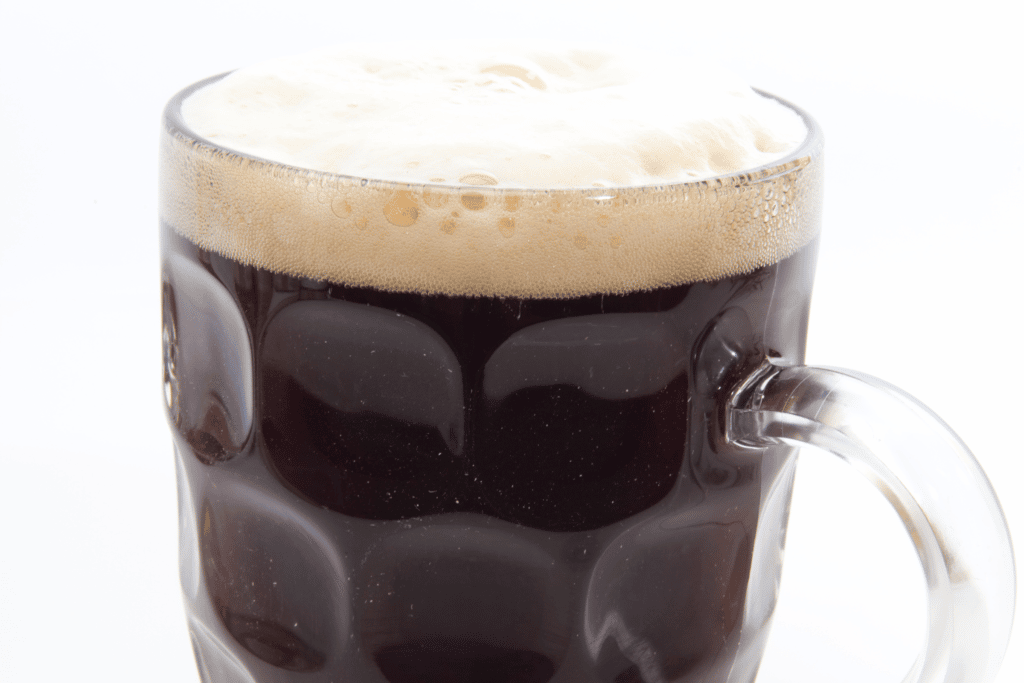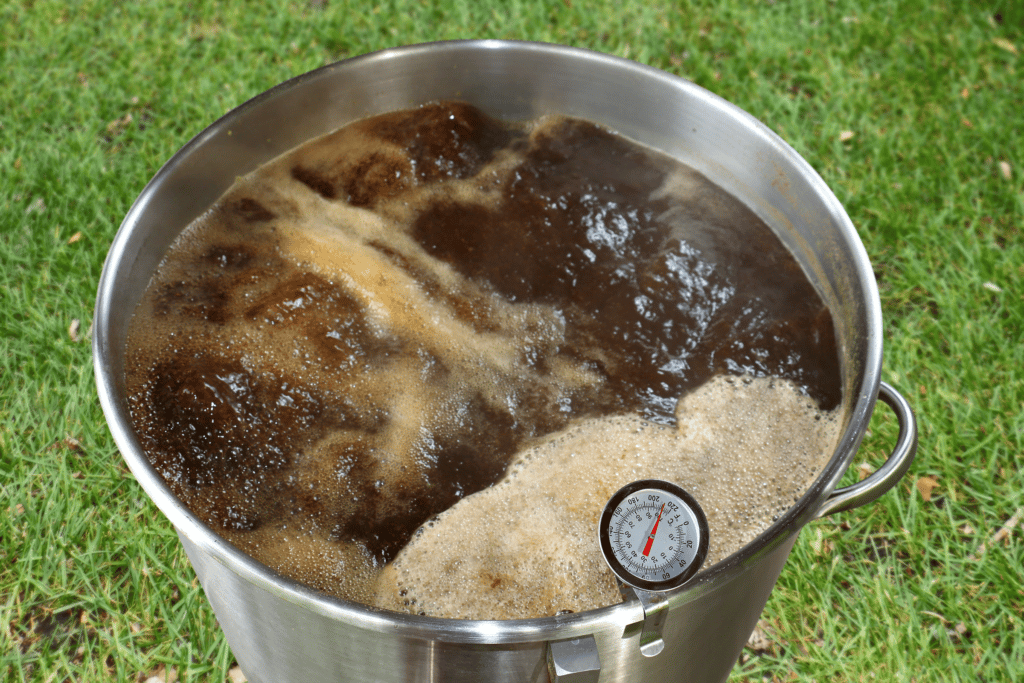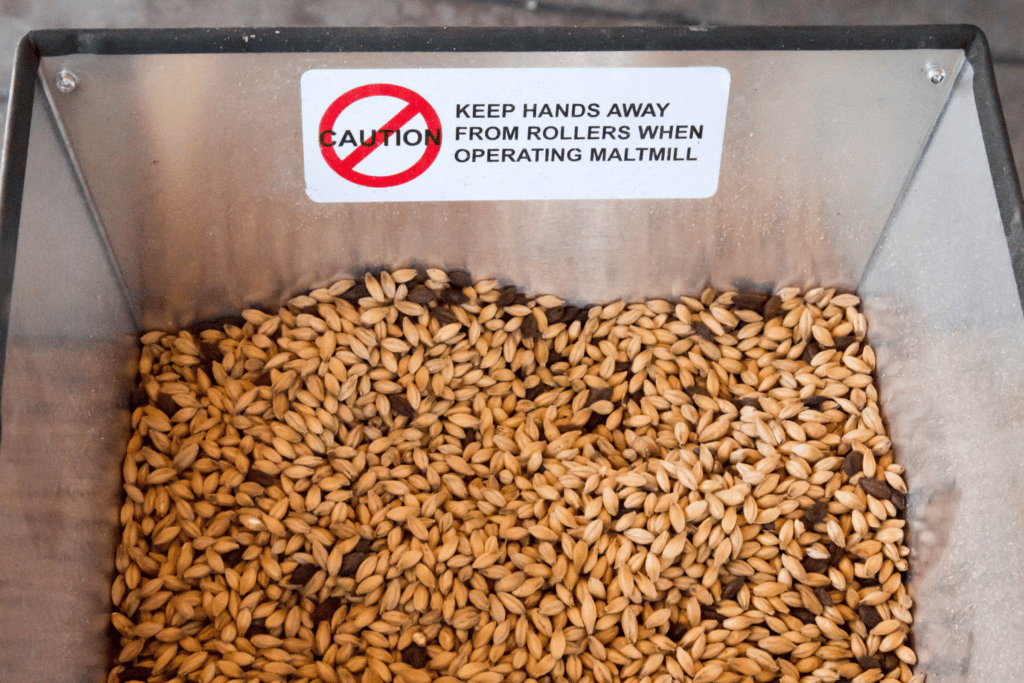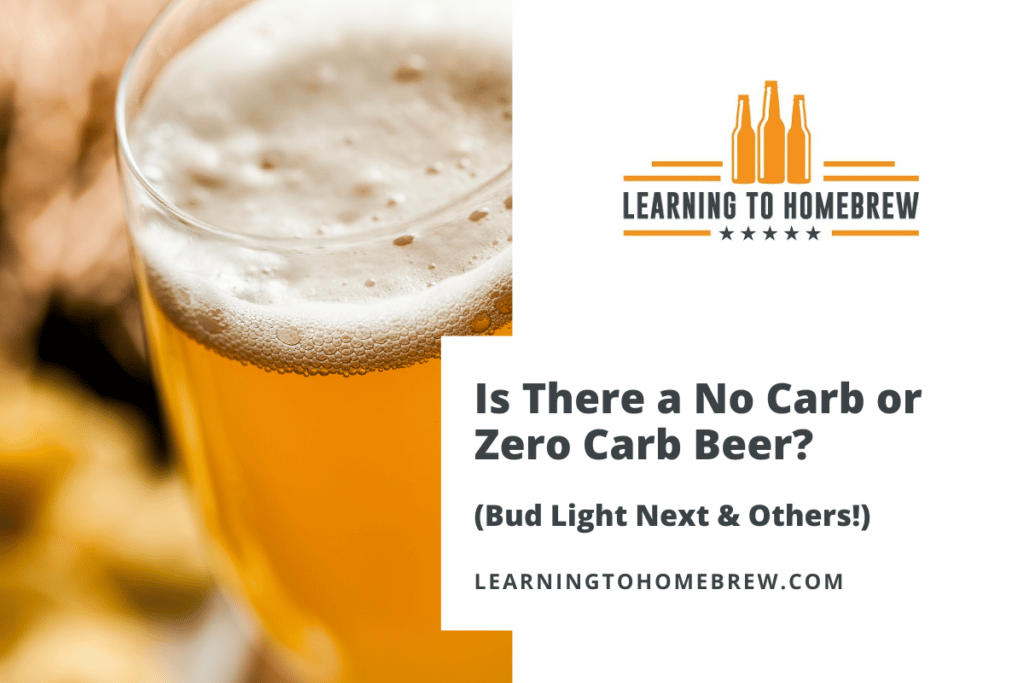Brown Ales are a great beer to pair with food. More than that though they are a tasty brew that fits any situation. If you want to make your own you need to know everything American Brown Ales and English Brown Ales – including how to brew them!
Brew a delicious Brown Ale using a water profile with more chlorides than sulfates or a balanced ratio. Pale 2-row malt along with chocolate or crystal specialty malts will be the core of the beer. Use a clean fermenting yeast for an American style or an English yeast for an English Brown. Finally, the best hops are those that go with malt flavors.
The Brown Ale may seem like a simple brew but it takes some planning and focus to master. Learn what the best ingredients are, how best to use them, and a few example recipes.
Topics We Cover
What is a Brown Ale?
Brown ales come in two main varieties: American and English Brown Ales. Both styles present malty flavors as well as notes of chocolate, toffee, and nuts. The American Brown Ale has more hop characteristics. The English style may have hop characteristics though not as strongly.
There is a decent level of variability within the style, whether the Brown Ale is following the American or English style. Typically the style leans towards malt flavors over hop but as mentioned above, the American style can include more hop-forward ales.
For the brews that have noticeable hop flavors and aromas, there isn’t a favorite hop variety. Many American Brown Ales will use American hops, however. Any hop that pairs well with malt flavors will work.
One aspect that Brown Ales shouldn’t have is a roasted quality. This would be too close to Porter territory.
- Color – 18 – 35 SRM
- Common flavor – Chocolate, toffee, nutty, caramel
- Aroma – Malt, caramel, nutty, toasty
- Mouthfeel – Effervescent, medium mouthfeel
- IBUs (Bitterness) – 20 – 30
- ABV – 4.3% – 6.2%

History of the Brown Ale
Brown Ales have existed since the late 1600s early 1700s. The Brown Ales of this age were a different style primarily categorized by the brewers’ use of brown malts. The use of these malts fell out of favor causing the Brown Ale to fade. It was revived in the 1920s.
Newcastle Breweries of Newcastle upon Tyne, England, brought the style back in 1927 with the release of Newcastle Brown Ale. When Newcastle Breweries merged with Scottish Brewers the Newcastle Brown became a national hit. By the 1980s it had made its way to popularity in America.
In the wave of Newcastle’s success, other brewers began brewing Brown Ales. Homebrewers took the style and created new variations of the English style. This is how the American Brown Ale came to be.
Popular commercial Brown Ales
For the beer enthusiasts and the beer curious here’s a quick list of Brown Ales you should try.
- Newcastle Brown Ale – This famous beer brings light bready flavors at first with subtle sweetness and earthy notes. It finishes with some mild hop notes.
- Big Sky Brewing Co. Moose Drool – Hoppier than Newcastle, Moose Drool balances coffee and cocoa with hop bitterness.
- Avery Brewing Ellie’s Brown Ale – A malt-forward beer, this Brown Ale has notes of vanilla and nutty flavors.
- Bell’s Brewery Best Brown Ale – This well-balanced brew brings cocoa and caramel flavors to the table.
Popular Brown Ale recipes (all-grain or extract)
Janet’s Brown Ale is the recipe for which Mike won the 2004 National Homebrew Convention gold medal in its category.
How to brew a Brown Ale
After trying a few pints of Brown Ale you may be thinking of how yours will taste. In order to brew the best beer you need to know the style forward and backward. To that end, I will break down everything you need to know.
Let’s start with great choices for the recipe and ingredients. Then, we can look at brew day, fermentation, and bottling.

Recipe and ingredients
While you can’t have beer without fermentation, you can’t get anywhere without quality ingredients. There are of course no wrong ingredients, but some will go together much better than others.
As always, start with your water. Since beer is nearly 90% water, good water makes good beer. Then consider your grain bill, hops, and finally yeast. Each one can have a large impact on your final product.
Water profile
Before you look at your water profile you need to decide what sort of Brown Ale you are going for. Whether you are brewing a more malt focused or hop focused Ale will determine the best water profile for your brew.
A malt-heavy Brown Ale will benefit from a water profile with more chlorides to sulfates. This will bring out the malt flavors without letting any hops overpower them. Reverse the ratio for a hop-forward Ale. A more balanced Brown Ale should also balance the chlorides and sulfates.
In addition to your chloride-to-sulfate ratio, make sure that you will meet a mash pH between 5.4 and 5.6. Depending on the water source you use, you may need to add some alkalinity. Use a brewing calculator such as Bru’n Water to make things easier.
Base grains
As this style is typically dominated by its malty flavors your base and specialty grains are quite important. Luckily it’s not a complicated decision. The choice of malts is pretty straightforward.
The majority of your Brown Ale’s grain bill should be a pale malt. US pale 2-row and Maris Otter are two great choices. These will provide the backbone for your malt flavors.
These base grains shouldn’t be the only grains you use. Instead, they should make up anywhere from 85% to 90% of your grain bill. Specialty malts will add more complex notes.

Specialty grains or other additions
Almost all Brown Ale recipes call for crystal and chocolate malts. These malts will add more complex malty flavors such as chocolate, sweetness, and nuttiness, depending on the coloration.
These malts can total up to 15% of your grain bill. Though this is merely a guideline and not a hard rule. Whether that’s one specialty malt or several is up to you. The crystal malts can be any range of Lovibond though the darker it is, the less you will need.
Chocolate malts don’t need to take up more than 10% of your grain bill. Any more than that will either make your beer too dark, overpower other flavors, or both.
Other specialty grains, such as flaked oats, can be considered if you desire a smoother mouthfeel.
Hops
Hops tend to play second fiddle in a Brown Ale though the American style does allow for a little more hop character to shine through. No matter how hoppy of a brew you are going for, you shouldn’t neglect them.
American Brown Ales tend to use American hop varieties. English Brown Ales tend to use English hops, on the other hand. Either style can make use of hops that balance well with malts.
Of course, hops serve two different purposes in a beer. Some are meant for bittering, while others are used for their flavor and aroma.
Bittering
Bittering hops added early in the boil will go through a process called isomerization. This is what gives a beer its bitterness. Most Brown Ales do not need much in the way of bitterness. American Brown Ales will have slightly more bitterness than English variants.
Here are some good choices for bittering hops.
| Name | Purpose | Alpha Acid % |
| Cascade | Bittering + Aroma | 4.5-7% |
| Willamette | Aroma | 4-6% |
| Chinook | Bittering + Aroma | 12-14% |
| US Golding | Aroma | 4-6% |
Aroma and Flavor
Aroma and flavor hops added towards the end of the boil don’t add much bitterness. Instead, they add oils that provide flavor and aroma. Floral, earthy, and fruity flavors are acceptable for an English-style Brown. Citrus, fruity, and tropical flavors can be found in American-style Browns.
As mentioned previously, what is most important is that the hop flavors and aromas work well with the malts. This gives you room to experiment.
Here are a few good choices to get you started.
| Name | Flavor/Aroma | Alpha Acid % |
| Cascade | Citrus, floral | 4.5-7% |
| Willamette | Floral, fruity, spice | 4-6% |
| Fuggles | Woody, floral, vegetal | 2.4-3.1% |
| Mount Hood | Herbal, floral, spice | 4-8% |
Yeast
Finally, the yeast and how it affects your brew. Since yeast can affect the dryness and flavors of your beer it is as important as any other ingredient.
English Brown Ales want yeast with light ester production, medium to high flocculation, and medium to high attenuation. American Brown Ales want yeast with little to no ester production and medium to high attenuation and flocculation.
Dry
Below are some good dry yeast options for a Brown Ale.
| Name | Attenuation | Flocculation | Temp Range |
| Safale US-05 | 78-82% | Medium | 64.4-78.8°F |
| Safale S-04 | 74-82% | Medium | 77°F-84°F |
| Nottingham | 77% | High | 50-72°F |
Liquid
Below are some good liquid yeast options for a Brown Ale.
| Name | Attenuation | Flocculation | Temp Range |
| Wyeast 1056 | 73-77% | Low – medium | 60°-72° F |
| WLP001 | 73-85% | Medium | 68°-73° F |
| WLP002 | 63-70% | Very high | 65°-68° F |
Brewing process for Brown Ales
After acquiring all of your ingredients you can move on to brew day. What you do on brew day can have just as much impact on your results as your choices of ingredients.
All grain, partial, and extract brewing each have important considerations for you to make. When doing all-grain or partial brewing you need to consider mashing and sparging. From there, the other considerations are similar. The boil step and on is the same for all three.
Let’s break down each step with the Brown Ale in mind.
Mashing
During your mash for a Brown Ale, keep the temperature around 154° F for an hour. This temp will ensure you get plenty of fermentable sugars while leaving the beer with a medium to full body.
If you want a drier Brown ale, you can mash around 150° F to 152° F. Mashing higher than 154° F isn’t recommended for this style as you don’t want it too sweet. If your water profile is well-tailored you won’t have to worry about the mash pH.
Boil
After mashing and sparging, it’s time for the boil.
The boil for a Brown Ale is no different than any other. Boil for at least an hour. Add your bittering hops right at the beginning or shortly after. Any aroma and flavor hops should be added just before the end of the boil.
If your bittering hops have a high alpha acid concentration you don’t need to add them right away. You should still add them fairly early, however. Anytime between an hour left and 45 minutes left will be fine.
As for your flavor and aroma hops you should add those at 15 minutes until the end at the earliest. Any earlier and you’ll mostly be getting bittering.
Whirlpool or flameout
Alternatively, you can add your hops just after the boil. This is when you add the hops during flameout, often with a whirlpool.
Adding hops during flameout allows you to get the hop oils without much if any bittering. At flameout, the wort is hot enough to tease out the hop oils but not hot enough to isomerize them.
Whirlpooling can be a great way to do this as it helps you separate the trub as well as extract hop oils.
Fermenting Brown Ales
The fermentation stage will be mostly waiting, but there are a few things to keep an eye on.
Most important to fermentation is the temperature. When brewing an American Brown Ale, keep your temps on the lower end of your yeast’s viable range. For an English Brown, you can keep the temps on the middle to high end.
Lower temps will discourage any ester production. Since American and English styles are slightly different in this regard it will depend on your goals.
Temperatures
While the temperature is yeast specific there is a general range to shoot for.
During fermentation try to keep your fermentor around 65° F for American Browns and around 68° F to 70° F for English Browns.
If your fermentation seems to lag at the lower temps don’t worry too much. It may start up again on its own or you can bump up the temps.
Bottling or Kegging Brown Ales
The debate between bottling and kegging will go on for as long as brewers have a choice. It is truly up to personal preference and setup.
There is no preference between bottling and kegging for Brown Ales. Choose the method that is easiest for you.
Brown Ale Recipes
If you aren’t one to create your own recipes, here are a few that you can follow for great results. Be sure to sanitize properly as always. These recipes are from various brewers, as credited below.
- Brown Ale w/ Wild Hops (All grain)
- Honey Brown Ale (Extract)
- Pete’s Wicked Ale (All grain)
Brown Ale w/ Wild Hops (All Grain)
This recipe comes from user keithouweneel@gmail.com on Brewer’s Friend.
Recipe
- US Pale 2-row – 10.3 lbs
- US Crystal 80° L – 1.5 lbs
- German – CaraMunich III – 1.5 lbs
- German – Carafa I – 0.5 lbs
- Rolled oats – 0.75 lbs
- East Kent Goldings hops – 2.4 oz
- WLP001
Instructions
- Heat 22 quarts of water to 154° F.
- Add grains and mash for 1 hour.
- Mashout.
- Collect 7.8 gallons of wort.
- Add 0.8 oz of the hops before the boil.
- Boil for 75 minutes.
- At 30 minutes left add 0.8 oz of the hops.
- At 20 minutes left add the rest of the hops.
- Flameout and transfer to the fermentor.
- Cool and pitch yeast.
- Maintain 68° F during fermentation.
- After a week in fermentation, rack to keg and force carbonate or bottle condition.
Honey Brown Ale (Extract)
This recipe comes from user Chill152 on Brewer’s Friend.
Recipe
- Liquid Malt Extract – Pilsen – 7 lbs.
- US Chocolate – 8 oz
- Canadian – Honey Malt – 8 oz
- US Crystal 60° L – 4 oz
- US Crystal 40° L – 8 oz
- Brewer’s Gold hops – 0.9 oz
- Safale US-05
Instructions
- Begin heating 7.5 gallons of water for your boil.
- Add the steeping grains when the water is around 140° F.
- Remove the grains when the water is around 170° F.
- When a boil is reached, add the malt extract.
- Boil for 60 minutes. Add the hops right away.
- Flameout and transfer to the fermentor.
- Cool and pitch yeast.
- Maintain 70° F during fermentation.
- After a week in fermentation, rack to keg and force carbonate or bottle condition.
Pete’s Wicked Ale (All Grain)
This recipe comes from user Richard F Shoff Jr on Brewer’s Friend.
Recipe
- US Pale 2-row – 7.78 lbs.
- US Crystal 60° L – 3.22 lbs.
- US Chocolate – 2 oz
- Brewer’s Gold hops – 35 g
- Cascade hops – 1 oz
- Slaked Lime – 2.5 oz
- Lactic acid – 1.44 ml
- Wyeast 1028
Instructions
- Heat 15 quarts of water to 154° F.
- Add grains and mash for 1 hour. Add the lactic acid at the beginning.
- Mashout.
- Collect 7.5 gallons of wort.
- Boil for 90 minutes.
- At 60 minutes left add 21 g of Brewer’s Gold and the slaked lime.
- At 15 minutes left add the rest of the Brewer’s Gold.
- Flameout and transfer to the fermentor.
- Cool and pitch yeast.
- Maintain 68° F during fermentation.
- After a week in fermentation, transfer to secondary. Add the Cascade.
- After a week in secondary, package as desired.
Did you know that we have a full library of homebrew beer recipes for every style?






